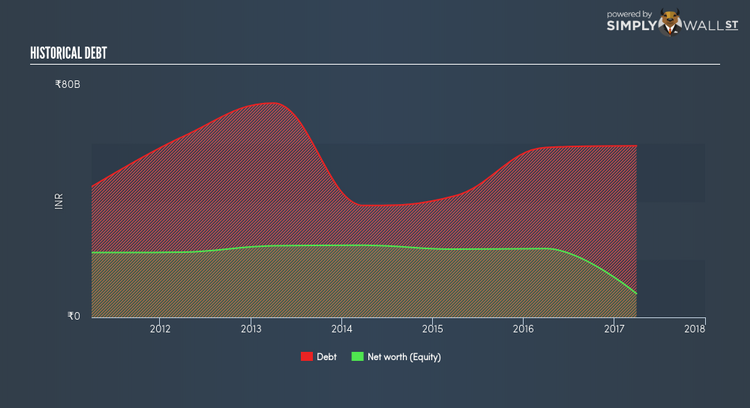What does Ruchi Soya Industries Limited’s (NSE:RUCHISOYA) Balance Sheet Tell Us About Its Future?

Investors are always looking for growth in small-cap stocks like Ruchi Soya Industries Limited (NSEI:RUCHISOYA), with a market cap of IN₨5.88B. However, an important fact which most ignore is: how financially healthy is the business? Given that RUCHISOYA is not presently profitable, it’s essential to evaluate the current state of its operations and pathway to profitability. I believe these basic checks tell most of the story you need to know. However, given that I have not delve into the company-specifics, I recommend you dig deeper yourself into RUCHISOYA here.
Does RUCHISOYA generate enough cash through operations?
RUCHISOYA’s debt level has been constant at around IN₨59.23B over the previous year made up of current and long term debt. At this constant level of debt, the current cash and short-term investment levels stands at IN₨1.61B for investing into the business. Additionally, RUCHISOYA has generated cash from operations of IN₨4.53B during the same period of time, resulting in an operating cash to total debt ratio of 7.65%, indicating that RUCHISOYA’s current level of operating cash is not high enough to cover debt. This ratio can also be a sign of operational efficiency for loss making businesses as traditional metrics such as return on asset (ROA) requires positive earnings. In RUCHISOYA’s case, it is able to generate 0.077x cash from its debt capital.
Does RUCHISOYA’s liquid assets cover its short-term commitments?
Looking at RUCHISOYA’s most recent IN₨121.69B liabilities, it seems that the business has not been able to meet these commitments with a current assets level of IN₨77.19B, leading to a 0.63x current account ratio. which is under the appropriate industry ratio of 3x.
Is RUCHISOYA’s debt level acceptable?
With total debt exceeding equities, RUCHISOYA is considered a highly levered company. This is not unusual for small-caps as debt tends to be a cheaper and faster source of funding for some businesses. But since RUCHISOYA is presently loss-making, sustainability of its current state of operations becomes a concern. Running high debt, while not yet making money, can be risky in unexpected downturns as liquidity may dry up, making it hard to operate.
Next Steps:
RUCHISOYA’s high debt level indicates room for improvement. Furthermore, its cash flow coverage of less than a quarter of debt means that operating efficiency could also be an issue. In addition to this, its low liquidity raises concerns over whether current asset management practices are properly implemented for the small-cap. This is only a rough assessment of financial health, and I’m sure RUCHISOYA has company-specific issues impacting its capital structure decisions. I suggest you continue to research Ruchi Soya Industries to get a more holistic view of the stock by looking at:
1. Valuation: What is RUCHISOYA worth today? Is the stock undervalued, even when its growth outlook is factored into its intrinsic value? The intrinsic value infographic in our free research report helps visualize whether RUCHISOYA is currently mispriced by the market.
2. Historical Performance: What has RUCHISOYA’s returns been like over the past? Go into more detail in the past track record analysis and take a look at the free visual representations of our analysis for more clarity.
3. Other High-Performing Stocks: Are there other stocks that provide better prospects with proven track records? Explore our free list of these great stocks here.
To help readers see pass the short term volatility of the financial market, we aim to bring you a long-term focused research analysis purely driven by fundamental data. Note that our analysis does not factor in the latest price sensitive company announcements.
The author is an independent contributor and at the time of publication had no position in the stocks mentioned.

